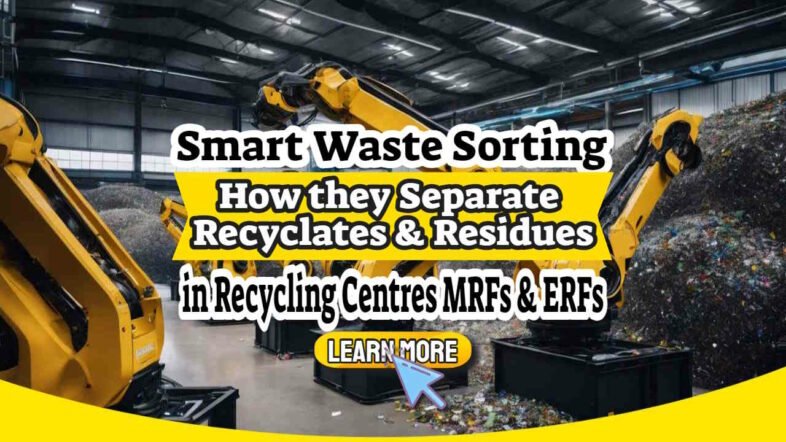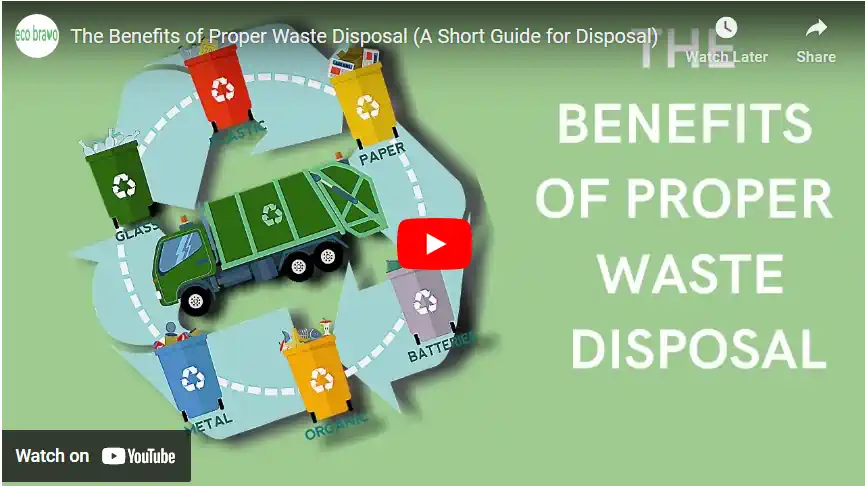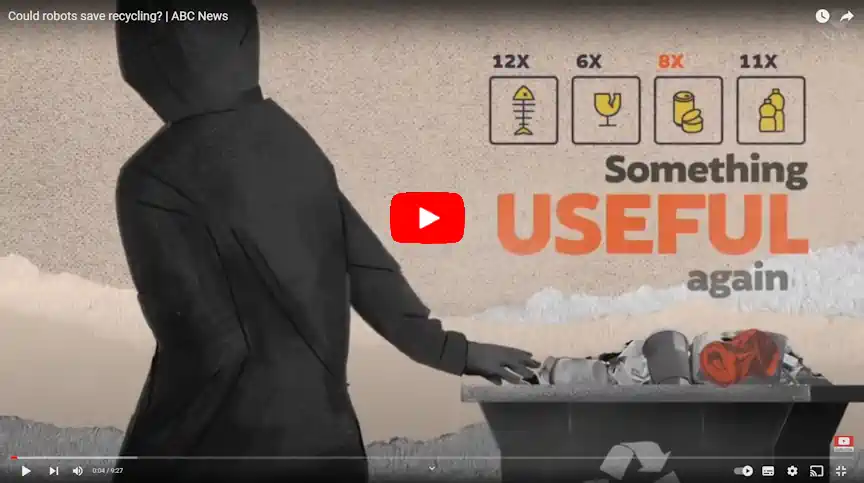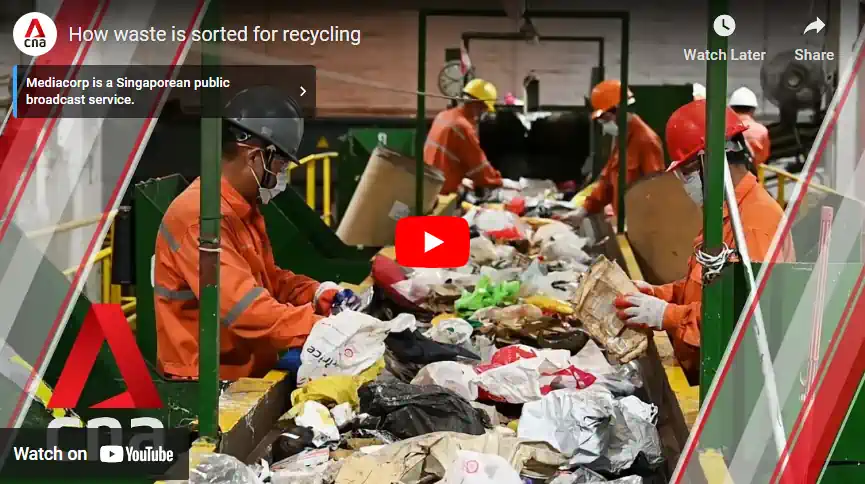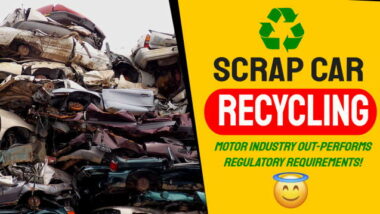Smart Waste Sorting: Sorting waste effectively in recycling centres poses a significant challenge amid escalating global waste issues. Today, smart waste sorting technology using AI is transforming this process by optimising the separation of recyclable materials from residual waste.
This article explores how cutting-edge robotics and artificial intelligence are just starting to streamline the handling of the waste influx in Material Recovery Facilities (MRFs) and Energy Recovery Facilities (ERFs).
Warning! Our featured image (See below) was created using artificial intelligence!
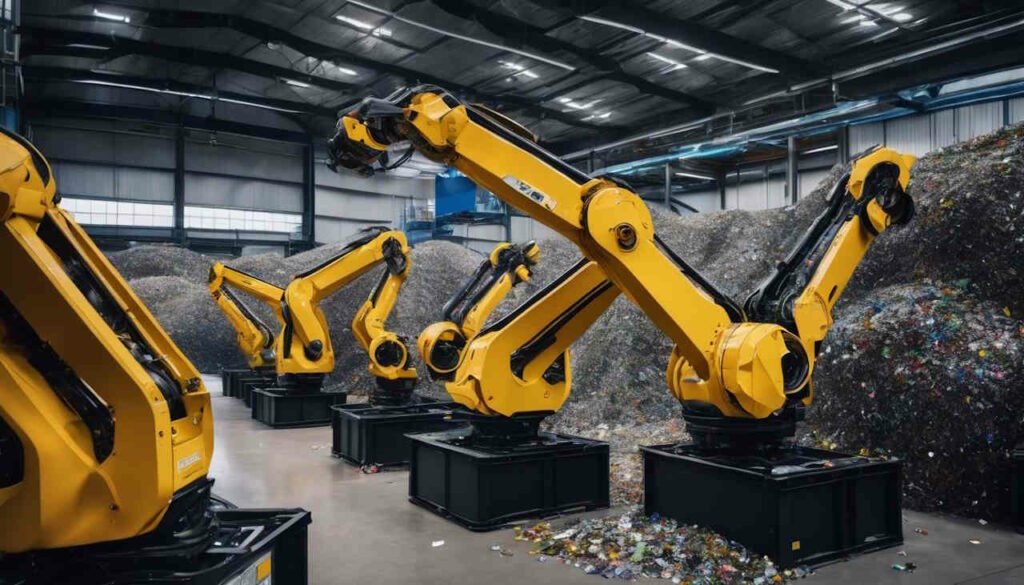
Although the view of the heavy robot arms often used in vehicle manufacturing is dramatic, robots of this type are never likely to be seen in an MRF, ERF or Municipal Recycling Centre!
They are far too big and unwieldy.
Instead, techniques such as AI-directed picking arms above conveyor belts and ballistic separation are used. In the ballistic separator, a blast of air is delivered to ballistically knock recyclates off the belt when seen by an AI camera, and to drop the recyclate into a bin.
Stay tuned to unravel how these innovative tech advancements are cleverly redefining the current approach towards sustainable waste management!
Key Takeaways
- Smart waste sorting technology, using robotics and artificial intelligence, is revolutionizing the separation of recyclable materials from residual waste in recycling centres and energy recovery facilities (ERFs).
- AI robots play a crucial role by using sensors and cameras to identify and separate different types of recyclables such as paper, plastics, glass, and metals with precision in the most modern of Recycling Centres. But, don't expect to see futuristic robots. The AI tech is built into ordinary-looking equipment on sorting conveyors and is easily missed
- The implementation of smart waste sorting systems increases the efficiency and accuracy of waste processing operations, resulting in higher-quality recycling products and reduced contamination.
- By optimizing recycling processes and increasing resource recovery rates, smart waste sorting contributes to a more sustainable waste management system that supports the principles of the circular economy.
The Importance of Waste Sorting
Waste sorting is crucial for effective recycling, as it involves pre-sorting and separating recyclables into single material streams, allowing for more efficient processing.
Pre-sorting
In the world of waste, pre-sorting takes up an important role. This is the first step at recycling centres.
Trucks bring in all types of trash and dump it into one big area called the reception bay or pre-sorting area.
Here, in the older centres workers look through everything by hand. They toss out things that can't be recycled, like full bags or big items. Also removed are harmful things like batteries and wires. After that clear-out, what remains moves to the next part for more sorting with mostly physical separation equipment but increasingly, with AI “robotics” controlled devices as well.
In the latest MRFs, ERF and Recycling Centres there is little, if any, human picking from a conveyor line. Bags are cut-open with the equipment and physical characteristics are used as a key to sorting
Sorting recyclables into single material streams
Smart waste sorting technology helps in sorting recyclables into single material streams, such as paper, plastics, glass, and metals. Waste sorting robots use advanced sensors and cameras to identify and separate different types of recyclable materials. This ensures that each type of material can be processed separately, which improves the efficiency and quality of the recycling process. By sorting recyclables into single material streams, we can increase the amount of materials that can be recycled and reduce waste going to landfill.
How AI Robots Work in Waste Processing Plants
AI robots are just beginning to play a crucial role in waste processing plants by using advanced technology to sort and separate different types of waste materials. These robots are equipped with sensors and cameras that can identify recyclable items such as paper, plastics, glass, and metals.
They may work instead of human operators to increase the efficiency and accuracy of the sorting process. But, rather than shiny robots, this AI usually lies buried within mundane-looking equipment.
When waste is brought to the processing plant, it goes through a pre-sorting area where non-recyclable items are removed. After this stage, the waste materials are moved into a sorting area where there AI robots remove specific recyclable materials, as a last resort when all else has failed after more general sorting.
For example, the different colours of glass cannot be distinguished by any physical characteristic but AI applications can be taught to select glass pieces on the basis of colour seen in a camera image.
The same applies to many plastics, especially bottles which AI robotics can select in a ballistic separator, or can be lifted via a suction pad and dropped over a bin of, for example, PET plastic resin bottles.
Using their sensors and cameras, these robots scan the waste and quickly identify the different materials used for sorting types of recyclables into specific (usually valuable) resins for reuse of that specific plastic in new products.
By automating this process, AI robots help to reduce human error and increase productivity in waste processing plants. They can sort materials at a faster rate than humans alone, leading to more efficient recycling operations.
This technology also helps improve the quality of recycled products by reducing contamination from non-recyclable items.
However, although AI systems are used more frequently every year, currently only the first two device types in the following list of waste-sorting equipment use AI:
- Ballistic Separators: Equipment that separates materials based on their weight and rolling characteristics.
- Optical Sorters: Use cameras and sensors to identify specific materials and use air jets or other means to separate them out.
- Trommels (Rotating Screens): Cylinder-shaped screens that separate materials by size.
- Vibrating Tables (or Screens): Tables that use vibrations to separate materials based on size and weight.
- Eddy Current Separators: Used to separate non-ferrous metals from other materials using magnetic fields.
- Overband Magnets: Used to capture and separate ferrous metals from the waste stream.
- Air Classifiers: Use air streams to separate materials based on density and shape.
- Baling Machines (or Balers): Compact and bundle recyclables, such as paper, cardboard, and plastics, into manageable blocks.
- Glass Crushers: Designed specifically to break down glass bottles and containers.
- Can Crushers: Crush and compact aluminium cans for recycling.
- Conveyor Belts: Transport waste materials through various stages of the recycling process.
- Shredders: Break down materials into smaller sizes for easier processing or disposal.
- Granulators: Used for further reducing the size of materials after shredding.
- Compactors: Reduce the volume of waste materials, making them easier to handle and transport.
- Bag Openers: Mechanically open plastic bags to release their contents for sorting.
- Depackaging Machines: Depackage and separate organic materials from everything else, primarily to provide an organic pulp to feed biogas plants.
- Windshifters: Use a combination of air, magnets, and mechanical parts to separate materials.
- Density Separators: Use gravity and other forces to separate materials based on their density.
- Near-Infrared (NIR) Sorters: Use infrared technology to sort plastics based on polymer type.
- Rotating Disc Screens: Separate materials based on size and shape by using a series of rotating discs.
- Finger Screens: Utilize elongated fingers to separate and sort materials.
- Crushers and Grinders: Used for reducing the size of bulky waste, making it easier to process or incinerate.
- Electrostatic Separators: Use an electric field to separate charged particles from neutral particles.
- Picking Stations: Manual sorting areas where workers remove contaminants and sort recyclables by hand.
- Vortex Separators: Separation of light material from heavy.
- Air Knife Systems: Utilize high-velocity air streams to separate light and heavy materials.
- Pelletizers: Process plastics and other materials into small pellets for recycling.
- Incinerators (for ERFs): Burn waste to produce energy in the form of heat, steam, or electricity.
- Boilers (for ERFs): Utilize the heat produced from incineration to generate steam and, subsequently, electricity.
- Ash Handling Systems (for ERFs): Collect, transport, and dispose of ash produced from incineration.
- Scrubbers (for ERFs): Reduce pollutants in exhaust gases before they are released into the atmosphere.
The Role of AI and Robotics in Waste Sorting
AI robots play a crucial role in waste sorting facilities, assisting with tasks such as clothing fibre line sorting and plastics recycling, ultimately making more items recyclable, and reducing the cost of waste sorting in MRFs.
AI robot assistance achieves a level of sorting not previously possible in waste sorting facilities
They can not only sort various materials such as paper, plastics, glass, and metals efficiently and accurately. AI robots play an essential role in waste sorting facilities by assisting in the sorting process where no physical property is present to differentiate each item.
These robots use advanced artificial intelligence and sensors to identify and separate different types of recyclable materials which are impossible to sort in any other way.
Recycling plastic from the waste stream such as HDPE plastic milk bottles from PET drinks bottles is an example of this, and one reason that so little plastic has, until now, been reused.
By automating this task, AI robots increase the speed of sorting and improve recycling operations' efficiency.
This technology helps optimize the recycling process by increasing the amount, and range, of materials that can be recycled while reducing waste going to landfills or energy recovery facilities. It also does it without exposing workers to the dangerous, dusty and noisy environments they must otherwise work in.
By raising the rates of recycling and reuse achieved, the implementation of AI robots in waste sorting facilities can significantly contribute to a more sustainable and efficient waste management system.
How AI robots reduce the cost of waste sorting in MRFs
AI robots help reduce the cost of waste sorting in MRFs (Material Recovery Facilities). They can work faster and more accurately than humans, which means that the sorting process is more efficient.
By automating the sorting process, less manual labour is required, leading to lower labour costs. Additionally, AI robots can identify and separate different types of recyclable materials with precision, reducing errors and contamination.
This helps increase the quality of recycling and reduces the amount of waste that ends up in landfills or needs further processing. Overall, using AI robots in waste sorting can optimize operations and save money for MRFs.
The Waste Sorting Process
Waste is transported to waste sorting facilities where it undergoes a meticulous sorting process, separating recyclables from non-recyclable materials. Curious to know how this process works? Keep reading to find out!
Transporting rubbish to waste sorting facilities
Rubbish is transported to waste sorting facilities to begin the process of separating recyclable materials from non-recyclable waste. This is an important step in the waste management system.
The rubbish is collected and taken to a pre-sorting area where any items that can't be recycled are removed. After this, the waste materials are moved into a sorting area where advanced robotics and artificial intelligence come into play.
These technologies use sensors and cameras to identify different types of recyclables like paper, plastics, glass, and metals. Once sorted, these recyclables can be further processed for recycling while non-recyclable residues are sent for disposal or energy recovery.
How waste may be sorted in the MRFs and ERFs of the future
In the future, the ubiquitous use of waste conveyor lines in these facilities may be removed. Instead, using advanced technology, robots may be used to pick all the items in the incoming waste avoiding the energy-intensive, low reliability, and high maintenance cost of existing mechanical separation and sorting equipment.
Here's how:
- Waste is brought to a pre-sort area for initial separation.
- Robots with sensors and cameras identify different types of recyclables.
- The robots separate paper, plastics, glass, and metals projecting them into colour (glass) and resin (plastics) specific bins.
- Recyclable materials are processed further for cleaning and grading for recycling.
- Non-recyclable residues are either disposed of in a landfill or used for energy recovery.
Preparing recyclables for reprocessing
Recyclables need to be prepared before they can be reprocessed. Here's how it's done:
- Recyclables are sorted into different categories, such as paper, plastics, glass, and metals.
- Any remaining contaminants or non-recyclable materials are removed to ensure the purity of the recyclables.
- The sorted recyclables are then compressed or baled for easier storage and transport.
- Labels and other non-recyclable components are also removed from the recyclables during this process.
- Once prepared, the recyclables are ready to be sent off for sale as materials, or reused as is, are sent on to specialist recycling facilities where they will be transformed into new products. An example of this is plastics which are sent to specialist plastics reprocessing companies to be washed and made up into bulk recycled resin beads.
Benefits of Smart Waste Sorting
In a nutshell, smart waste sorting offers numerous benefits, including increased quality of recycling, reduction of residual waste, improved efficiency and accuracy, and a significant contribution to the circular economy.
Reduction of residual waste
Smart waste sorting technology plays a crucial role in reducing residual waste. With the help of advanced robotics and artificial intelligence, the sorting process becomes more efficient and accurate.
These smart robots can identify and separate different types of recyclables from the waste stream, ensuring that only valuable materials are sent for recycling. By minimizing the amount of non-recyclable residues that end up in landfills or energy recovery facilities, smart waste sorting systems contribute to a more sustainable waste management system.
This not only reduces environmental pollution but also maximizes resource recovery, making our recycling efforts more effective overall and reducing the demand for the planet's finite mining reserves.
Improved efficiency and accuracy
Smart waste sorting technology has greatly improved the efficiency and accuracy of waste sorting processes in recycling centers and energy recovery facilities. With the use of advanced robotics and artificial intelligence, waste sorting robots can quickly identify and separate different types of recyclables with precision.
This automation not only speeds up the sorting process but also reduces errors, ensuring that materials are sorted correctly and minimizing contamination. As a result, more recyclable materials can be recovered, leading to increased resource recovery and reduced waste going to landfill.
The implementation of smart waste sorting systems has revolutionized waste management by optimizing recycling operations for greater efficiency and accuracy.
Contribution to the circular economy
Smart waste sorting technology plays a crucial role in contributing to the circular economy. By efficiently separating recyclable materials from residual waste, it ensures that valuable resources can be recycled and reused instead of ending up in landfills.
This not only reduces the amount of waste sent for disposal but also conserves natural resources and energy. Additionally, smart waste sorting technology improves the quality of recycled materials by reducing impurities, making them more suitable for manufacturing new products.
With its ability to optimize recycling processes and increase recycling rates, this technology helps create a sustainable and efficient waste management system that supports the principles of the circular economy.
Conclusion to “Smart Waste Sorting”
In conclusion, smart waste sorting technology plays a crucial role in separating recyclates from residues in recycling centres and energy recovery facilities. By using advanced robotics and artificial intelligence, these systems can improve the efficiency and accuracy of waste sorting processes.
This not only increases the quality of recycling but also contributes to a more sustainable and efficient waste management system overall. With the implementation of smart waste sorting systems, we can move towards a greener future by still further reducing landfill waste and promoting resource recovery.
FAQs
1. How does smart waste sorting separate recyclates from residues?
Smart waste sorting uses advanced technology such as sensors and optical scanners to identify and separate different types of recyclable materials from non-recyclable residues.
2. What happens to the separated recyclates in recycling centres (MRFs) and energy recovery facilities (ERFs)?
The separated recyclates in recycling centres are processed, sorted further, and then sent to be recycled into new products. The separated residues in energy recovery facilities are treated through methods like incineration where conversion into energy occurs.
3. Can I recycle all types of materials using smart waste sorting?
No, smart waste sorting can handle a wide range of materials including paper, plastic, glass, metal, and some electronic waste. However, certain items will still require specialized recycling processes outside the scope of smart waste sorting.
4. Is it better to use smart waste sorting compared to manual sorting?
Yes, using smart waste sorting is more efficient than manual sorting as it allows for faster processing speeds and higher accuracy in separating recyclables from non-recyclables. It is also healthier the avoidance of dirty Belt Picking jobs. Reducing human line-picking it reduces the risk of human injury, long term exposure to dust and dirt, while removing the possibility of human error and improving overall recycling rates.


